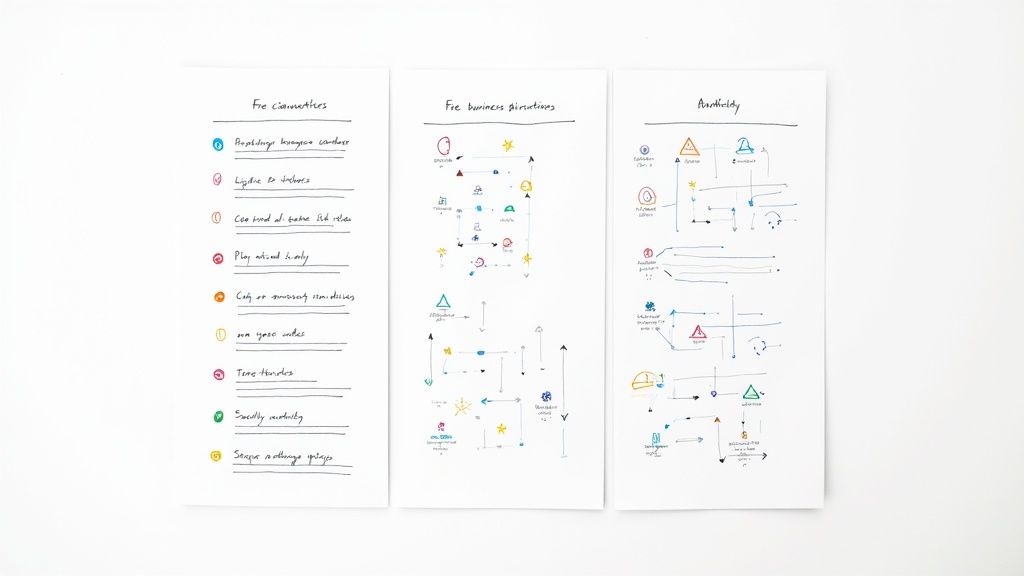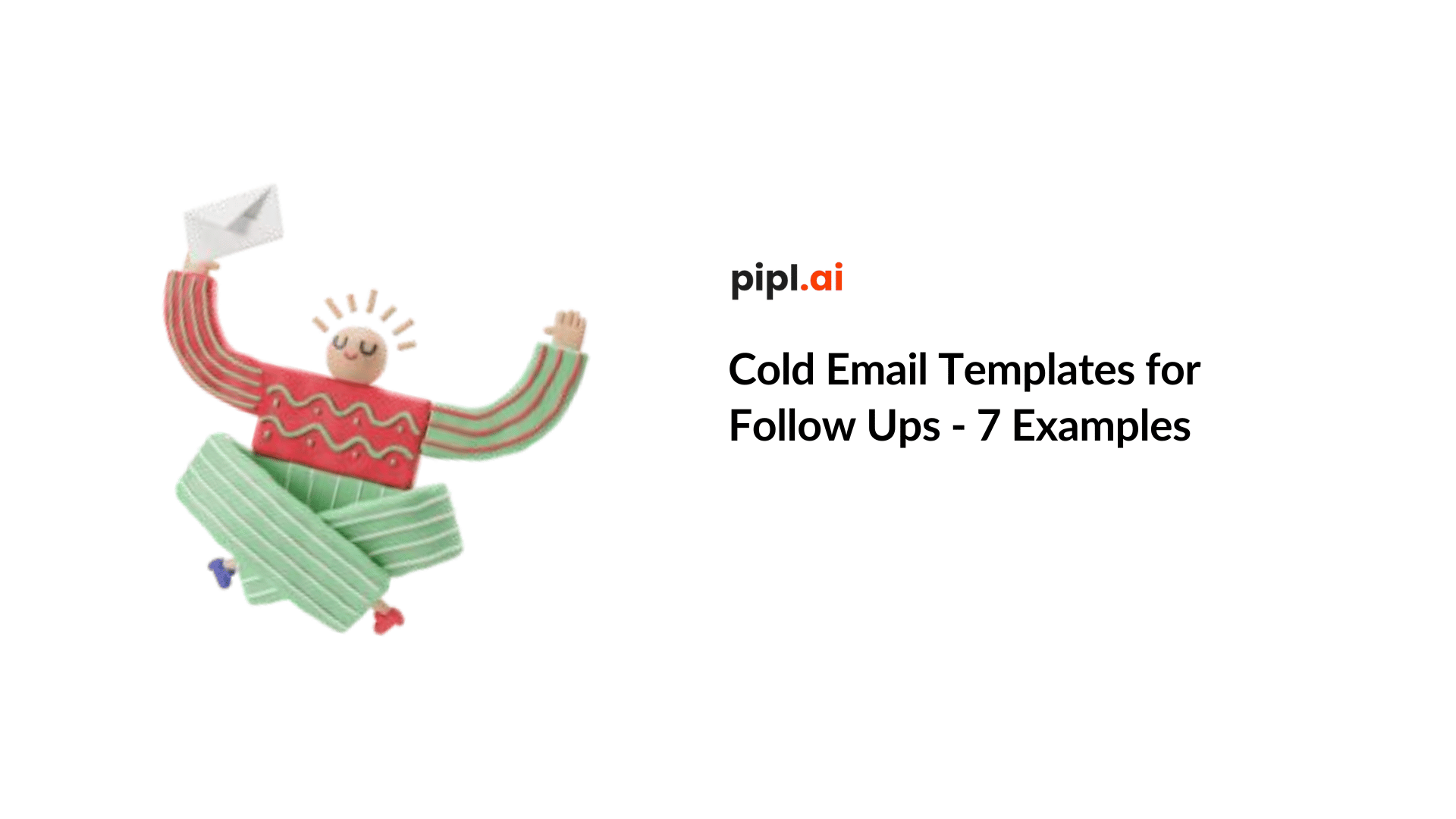Getting Started With AI Sales Prospecting Without Breaking Everything

Let's be real—bringing AI for sales prospecting into your workflow can feel like performing open-heart surgery on your sales process. But it doesn't have to be a massive, panic-inducing event. The key is to start small, show the value, and build momentum. Forget about a huge, top-down overhaul; think of it as adding a new, super-efficient assistant to your team.
The fear often stems from a misunderstanding of what these tools actually do. They aren't here to replace your talented sales reps. They're designed to take over the tedious, mind-numbing tasks that reps dislike anyway, like hours of manual research or drafting first-pass emails. AI handles that, freeing your team to do what they do best: build relationships and close deals. Getting this perspective across is the first step toward getting everyone on board.
Finding Your AI Champion and First Project
Every successful tech adoption needs a champion—someone on the team who is genuinely excited about what's possible. This person doesn't need to be a manager; often, it's a tech-savvy SDR who is fed up with the old, slow methods. Give this person the lead on a small pilot project.
Your first project should focus on a specific, measurable pain point. Don't try to solve every problem at once. Pick one area where your team is clearly struggling.
- Is lead research a major bottleneck? Start with an AI tool that automates gathering prospect data.
- Are your open rates in the gutter? Pilot a platform that generates personalized subject lines and opening hooks.
- Struggling to keep up with follow-ups? Test a system that suggests timely and relevant follow-up messages.
By zeroing in on one clear issue, you can achieve a quick win. This creates a powerful success story that will convince skeptics far more effectively than any high-level presentation ever could.
Setting Realistic Expectations
One of the biggest mistakes is expecting miracles overnight. AI is powerful, but it needs time to learn and be fine-tuned. Set a realistic timeline for seeing results, like tracking key metrics over a 30 or 60-day pilot. The use of AI in sales is already common and showing clear results. For instance, over 54% of sales teams now use AI for personalizing emails, and 45% rely on it for account research. Interestingly, another 45% use a hybrid approach, mixing AI efficiency with the expertise of human SDRs, which shows this is about support, not replacement. You can find a deeper dive into these prospecting trends on Outreach.com.
Communicating this hybrid vision is crucial for team morale. Position the AI as a new teammate that takes care of the grunt work, allowing your human reps to operate at a more strategic level. To see how this can play out, it's helpful to understand what AI can do for interactive video in a sales context, which can add another powerful, engaging element to your outreach. With a clear plan, an internal champion, and realistic goals, you can integrate AI for sales prospecting smoothly and set yourself up for long-term success.
Building Your AI-Powered Research Machine That Actually Delivers
The days of spending half your morning manually digging through LinkedIn profiles and news articles are over. Or at least, they should be. The real advantage of AI for sales prospecting isn't just about sending more emails; it’s about making every single piece of outreach count. This starts with building an intelligent research engine that feeds your team the exact insights they need, right when they need them.
Think of it like this: a traditional sales rep is a detective working a case with a few scattered clues. An AI-powered rep has a full forensics team backing them up, analyzing every digital footprint a prospect leaves behind. This isn't about replacing the detective's intuition; it's about giving them an undeniable advantage. The goal is to move beyond basic company info and build a living, breathing profile of your ideal customer.
From Data Points to Actionable Intelligence
The first step is to connect your AI tool to the right data sources. This is where you teach your new "research assistant" where to look for clues. A solid AI platform can pull information from a variety of places to build a complete picture.
- Social & Professional Networks: Go beyond a prospect's job title on LinkedIn. AI can track their recent posts, comments, group memberships, and even changes in their bio that might signal a new initiative.
- Company News & Press Releases: Is the prospect's company launching a new product, securing funding, or hiring for a new department? These are powerful buying signals that AI can flag automatically.
- Job Postings: A company hiring for roles that your product supports is one of the strongest indicators of need. AI can monitor job boards and alert you the moment a relevant posting goes live.
- Website Activity: When integrated with your site analytics, AI can identify which prospects are visiting your pricing page or reading specific blog posts, turning anonymous traffic into warm leads.
This automated process turns what used to be hours of manual labor into a background task. Instead of reps spending their prime selling time on research, they receive a daily digest of actionable insights. To get a better sense of how this works in practice, you can explore our complete guide to automate prospect research with modern tools.
To help you choose the right platform, here's a look at some of the leading tools that can help you build this research machine.
As you can see, the "best" tool really depends on your specific needs—whether it's the depth of data enrichment like Clay or the all-in-one approach of Apollo.io. Consider which features will most directly impact your team's workflow.
Integrating Insights into Your CRM
Gathering intelligence is only half the battle; making it accessible is what closes deals. The best AI prospecting tools don't just dump data into a spreadsheet. They integrate directly with your CRM, enriching your existing contact records with fresh, relevant information. This ensures that when a rep opens a prospect’s profile, they see more than just a name and number.
They see a story:
- Recent Pain Points: "Just saw on Twitter they're frustrated with their current software's downtime."
- Buying Signals: "Their company just posted a job for a 'Growth Marketing Manager'—they're looking to scale."
- Personal Connection: "They commented on a LinkedIn post about a conference you both attended."
This level of detail, delivered automatically, is what separates a generic cold email from a conversation-starting message. It empowers your team to lead with value and demonstrate that they’ve done their homework, building trust from the very first interaction.
Crafting Personalized Outreach That Gets Actual Responses

We've all seen them: the generic emails that land in our inboxes and get deleted without a second thought. They're the black hole of sales—your message gets sucked in, never to be seen again. Prospects can spot a mass-blasted template from a mile away. This is where using AI for sales prospecting becomes a game-changer, turning your AI from a simple research tool into a creative partner that helps you write messages that feel human.
The real magic isn't just about dropping in a name and company. Genuine personalization shows you've done your homework and understand your prospect's world. AI can quickly go through all the data you’ve collected—LinkedIn updates, company news, job postings—to find the perfect "in." It finds conversational hooks that you might miss, letting you lead with relevance instead of a tired pitch.
Moving Beyond {{FirstName}}
Strong personalization is about layering insights to tell a compelling story. At the bottom layer, you have the basics like name and company. Moving up, you add role-specific challenges and recent company news. At the very top, you use personal triggers like a recent LinkedIn post or a shared connection. AI makes it possible to build this multi-layered approach for every prospect, at scale.
Here's how you can use AI to build stronger connections:
- Trigger-Based Openers: Instead of the old "Hope you're having a great week," an AI can suggest something like, "Saw your company just secured Series B funding to expand the engineering team—congratulations!" This immediately shows you're paying attention to what's happening in their world.
- Pain Point Resonance: AI can look at a prospect's industry and job title to guess their main challenges. For a VP of Marketing, it might help you write an email that talks directly about cutting customer acquisition costs, even pulling in recent industry trends to back it up.
- Value Proposition Alignment: The platform can connect your product's features to what the prospect actually needs. If they just brought on a new Head of Sales, the AI might point out that you should highlight your tool's sales coaching and performance analytics features.
The idea is to craft a message so specific it feels like it could only have been written for that one person. If you want to dive deeper into this, our guide on cold email automation offers more advanced strategies for creating these highly customized sequences.
Crafting Subject Lines and CTAs That Convert
Even the best-written email is worthless if it never gets opened. AI can be a huge help in A/B testing your subject lines to see what your audience responds to. It can analyze countless data points to suggest subject lines that are interesting without sounding like clickbait.
Your call-to-action (CTA) also needs to be clear and easy to agree to. Instead of a demanding "Can you talk for 30 minutes tomorrow?" AI might suggest a softer approach based on your email's content, like, "If this resonates, would you be open to a 15-minute call to explore how we've helped similar SaaS companies?"
This data-backed approach makes a real difference. Using AI for sales prospecting isn't just about saving time; it's about getting real business results. Studies show that 70% of sales teams using AI have seen an increase in their average deal size. On top of that, this smarter prospecting method has been tied to a 76% increase in win rates. You can read the full survey findings about AI's impact on sales at ZoomInfo to see the complete picture. When you shift from generic templates to AI-assisted personalization, you're not just sending emails—you're starting valuable conversations that lead to revenue.
Optimizing Your Workflow For Maximum Impact (Not Just Speed)
When it comes to AI for sales prospecting, efficiency is where the technology truly shines. But simply chasing speed without a clear plan can lead to a lot of activity with very few results. The real win isn't just about doing things faster; it's about doing the right things more effectively. By structuring your workflow to let AI handle the heavy lifting, your team can focus on what they do best: building genuine connections and closing deals.
Think of it like a high-end workshop. You wouldn't put your master craftsman on the assembly line tightening bolts all day. You'd automate that repetitive task so they can apply their skills to the intricate, high-value finishing touches. The same logic applies to your sales team. Let smart automation take over the tasks that drain time and energy from even your top performers.
Automating the Grind to Free Up Your Stars
Let's get down to brass tacks. The most significant advantage of an AI-powered workflow is its ability to manage the behind-the-scenes grunt work that eats up a sales rep's day. Setting up intelligent automations reclaims precious hours that can be channeled directly into selling.
Here’s what that looks like in a real-world scenario:
- Intelligent Lead Scoring: Instead of manually digging through a mountain of leads, AI can analyze and score them based on firmographic data, online behavior, and past engagement. This brings the most promising opportunities straight to the top of the list, so your team is always focused on high-potential prospects.
- Automated Data Entry: Let’s be honest, nobody gets into sales for the love of CRM updates. AI can automatically log emails, calls, and meeting notes, keeping contact records rich and up-to-date without any manual work from your reps.
- Smart Follow-Up Scheduling: AI can analyze past interactions to pinpoint the ideal time for a follow-up email or call. This simple but powerful feature ensures no lead ever slips through the cracks because of a manual oversight.
To get a deeper understanding of how to build these systems from the ground up, an essential marketing automation workflow guide can offer a solid foundation.
Fine-Tuning Your AI Engine for Peak Performance
Once you've automated the repetitive tasks, it's time to focus on optimizing performance. Your AI is not a "set it and forget it" solution; it's a dynamic system that improves with the right input. One of the best ways to provide that input is through constant testing and refinement.
Start by A/B testing different parts of your AI-generated outreach. Experiment with various subject lines, opening hooks, and calls-to-action to discover what truly connects with your audience. For more advanced strategies, you can explore these top tips to get a 20% reply rate.
The results of this approach can be dramatic. Sales teams using AI have reported up to a 50% increase in both lead generation and appointments. This jump in prospecting activity is vital when you remember that most deals require multiple interactions—often eight or more—to close. You can discover more about these sales prospecting insights on Copy.ai to see just how important persistence is. By optimizing your workflow, you're not just accelerating the process; you're building a more resilient and effective sales engine that consistently delivers results.
Measuring What Matters (Beyond Vanity Metrics)

There's an old saying: what gets measured gets improved. This is especially true when you bring AI into your sales prospecting. But tracking the wrong numbers is like using a broken compass—it feels like you're moving, but you're just going in circles. Chasing vanity metrics like email open rates can feel productive, but it rarely connects to actual revenue. An opened email that's immediately deleted is a hollow victory.
To figure out if your AI strategy is really paying off, you need to zero in on metrics that directly link to sales success. This means looking past the surface-level data and getting to the real story of your pipeline's health. It’s all about drawing a clear line from that first AI-powered touchpoint to a closed deal.
From Clicks to Conversions: The KPIs That Count
A solid tracking system is your foundation. Your dashboard should map out the entire prospect journey, not just the first click. Let's start by shifting our attention from opens to genuine engagement. A high positive reply rate is far more valuable than a high open rate because it means your message was compelling enough to earn a response.
But even a reply isn't the finish line. The real objective is turning that conversation into a qualified meeting. This is why your meeting conversion rate—the percentage of positive replies that result in a booked call—is a critical sign of your outreach quality. If this number is low, it might mean your opening line is great, but your follow-up or value prop isn't strong enough to close the loop. Of course, all this is pointless if your emails are going to spam. If you're concerned, it's always a good idea to review some proven strategies to prevent emails from going to spam.
Beyond just booking meetings, you should also be watching metrics that show how your pipeline is moving and the quality of the deals.
- Deal Velocity: Are leads sourced by AI moving through your sales funnel faster than your other leads? A quicker pace usually points to better-quality leads and more effective messaging.
- Customer Lifetime Value (LTV): Do customers from your AI campaigns stick around longer or spend more over time? This long-term perspective shows the true return on your investment.
- Win Rate by Sequence: Which specific AI-generated outreach campaigns are bringing in the most closed-won deals? Identifying your top performers lets you double down on what truly works.
To help you get started, here’s a breakdown of the key metrics you should be tracking to gauge the effectiveness of your AI prospecting.
Key AI Prospecting Metrics to Track
Essential KPIs and benchmarks for measuring AI prospecting performance
By focusing on these core performance indicators, you gain a much clearer understanding of your AI's real-world impact. This data-driven feedback is what allows you to constantly refine your AI for sales prospecting strategy, making sure every automated touchpoint brings you closer to what really matters: sustainable growth.
Navigating Common Pitfalls (And How To Avoid Them)
Jumping into AI for sales prospecting is exciting, but it’s not all smooth sailing. There are a few potential tripwires you should know about ahead of time. Honestly, knowing what they are can be the difference between a successful launch and a frustrating false start. Every sales leader who has made these tools work has a few stories about the bumps they hit along the way. The good news? You get to learn from their experience.
One of the most common—and damaging—issues is poor data quality. You’ve probably heard the saying "garbage in, garbage out," and it’s never been more true. Your AI is only as smart as the information you give it. If your CRM is a mess of outdated contacts, incomplete profiles, or duplicate entries, your AI's suggestions will be just as messy. This leads to reps wasting time on leads that go nowhere. That's why keeping your data clean isn't just a "nice-to-have"; it's a must-do for success.
Taming the Data Dragon and Integrating Your Tech
Before you even think about launching a new AI tool, you need to get your data house in order. This means doing a full audit and cleanup of your current CRM data. I know, it’s not the most thrilling task, but it’s absolutely essential.
Once your data is clean, the next challenge is integration. A shiny new AI tool that doesn’t connect with your existing tech stack will just create more headaches and manual work for your team.
- Prioritize Seamless Connections: Look for AI platforms that offer native integrations with your CRM, like Salesforce, email client, and other essential sales tools. This stops your team from having to toggle between different apps, which is a major productivity killer.
- Start with a Pilot Program: Don't try to connect everything all at once. Begin with a small pilot team and a single, key integration, like syncing AI-generated insights back into your CRM.
- Get Your Team Involved: Your reps are the ones who will be in the trenches with these tools every day. Involve them in the integration process to make sure the final workflow actually helps them, rather than hinders them.
The screenshot below shows how AI insights can be embedded directly into a CRM, giving reps crucial information without forcing them to switch tabs.
This is the kind of setup you should be aiming for. It makes the AI feel like a natural part of the process, not some clunky add-on.
Overcoming Resistance and Staying Authentic
Even with perfect data and flawless integration, you might hit a wall with your own team. The fear that "AI is coming for our jobs" is real, but it usually comes from a place of misunderstanding. To tackle this, leadership needs to be crystal clear with their vision: AI is here to assist their skills, not replace them. Frame it as a way to get rid of boring, repetitive tasks so they can focus on what they do best—strategic thinking and building real relationships.
Finally, there's the challenge of sounding human. Leaning too heavily on automation can make your outreach feel robotic and generic, which is a quick way to get ignored. The trick is to find the right balance. Use AI to generate a first draft or uncover a compelling insight, but always empower your reps to add their own personal touch.
For a deeper dive into mastering this balance, our article on these prospecting secrets offers some great, practical advice. By thinking about these potential issues ahead of time, you can build a strong AI prospecting system that your team embraces and your prospects actually respond to.
Your Implementation Roadmap For AI Prospecting Success
Putting a plan into action is what truly separates the teams that win from those that just have good ideas. Let's walk through a practical roadmap to get your AI for sales prospecting off the ground and delivering real results. The goal here is to build a system that grows with you, not a one-off project that loses steam.
Setting Up For Scalable Success
First things first, you need a solid system for keeping score and making sure everyone's accountable. If you don't know what success looks like, you're just guessing. Define your goals from day one, but focus on metrics that actually impact revenue—not just activity. A common pitfall is obsessing over vanity metrics like open rates, which don't paint the full picture of your success.
Instead, give your team a simple checklist to get started on the right foot:
- Establish Key Metrics: Don't get lost in the noise. Prioritize tracking positive reply rates, the number of meetings booked, and how many qualified opportunities your AI campaigns generate.
- Set Realistic Expectations: You won't see magic overnight. Aim for steady, measurable improvements over the first 90 days. AI needs data and a bit of time to figure out what resonates with your specific audience.
- Assign Ownership: Put someone in charge. Designate a clear owner for the AI prospecting program who is responsible for tracking performance and helping the team adopt the new tools.
This simple infographic breaks down the core feedback loop you'll use to fine-tune your efforts.

As you can see, it's a straightforward cycle: measure your activities, analyze what the results are telling you, and then use those insights to make your AI models even smarter.
Maintaining Momentum and Avoiding Stagnation
Once you have everything up and running, the real challenge is keeping the momentum going. The initial excitement of a new tool can wear off, so it’s important to build a culture of continuous improvement. Make it a habit to regularly review what’s working and what isn't, and don't be afraid to try new approaches. To see how AI fits into your broader efforts, it's helpful to explore a variety of top B2B lead generation strategies. This gives you a bigger-picture view of your entire sales motion.
Always remember that AI for sales prospecting is a tool to support your team, not a replacement for solid sales fundamentals. Its job is to give your reps better insights and free up their time to do what they do best: build relationships and close deals.
Ready to see how a dedicated AI platform can change your outreach game? Discover how PlusVibe can supercharge your prospecting efforts and help you close more deals.














































.jpeg)


.png)























































